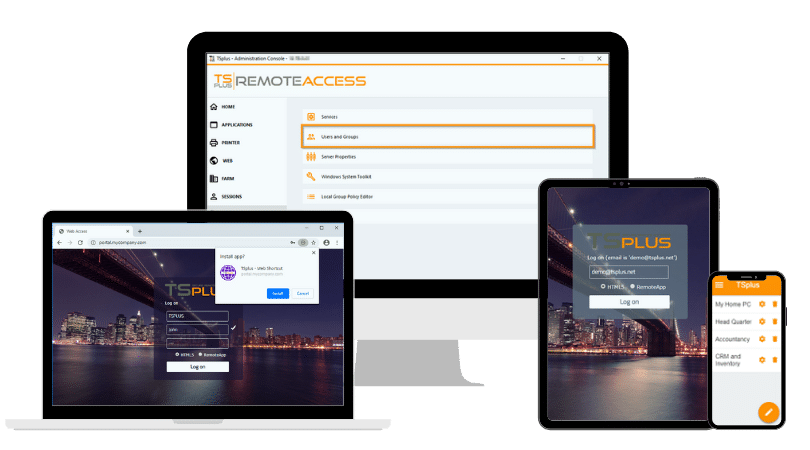"What is RDP Remote Desktop Software?"
Discover in this article what RDP Remote Desktop Software is, how it works, its key features, benefits, use cases and security best practices.
Would you like to see the site in a different language?
TSPLUS BLOG
Remote Desktop Protocol (RDP) is an essential tool for IT professionals, allowing remote management and access to computers over a network. Understanding RDP port numbers is crucial for configuring secure and efficient remote connections. In this article, we’ll dive into what RDP port numbers are, how they function, common configurations, and best practices for managing and securing these ports.
)
Before delving into the specific port numbers associated with RDP, it’s important to understand the protocol itself and why ports are critical to its operation.
Remote Desktop Protocol (RDP) is a proprietary network communication protocol developed by Microsoft. It is designed to provide remote access to another computer’s graphical interface, enabling users to control that machine as though they were sitting in front of it. This capability is invaluable for IT support, system administration, remote work, and troubleshooting, allowing authorized users to access servers, workstations, and virtual machines over a local network or the internet.
RDP operates on a client-server model, where the client (typically using the Microsoft Remote Desktop Client (mstsc.exe) on Windows or equivalent clients on macOS, Linux, or mobile devices) initiates a connection to an RDP server. The RDP server is usually a Windows-based system running Remote Desktop Services (RDS) or a configured workstation with remote desktop enabled.
The RDP protocol supports a wide range of features beyond basic screen sharing, including clipboard sharing, printer redirection, file transfers, audio streaming, multi-monitor support, and secure communication via SSL/TLS encryption. These features make it a versatile tool for both home users and enterprise environments.
Port numbers are an essential aspect of how network communication is managed. They are logical identifiers that ensure network traffic is directed to the correct application or service running on a system. In the context of RDP, port numbers determine how RDP traffic is received and processed by the server.
When an RDP client initiates a connection, it sends packets of data to the server’s IP address on a specified port number. If the server is listening on this port, it will accept the connection and begin the RDP session. If the port is incorrect, blocked by a firewall, or misconfigured, the connection will fail.
Port numbers are also crucial for security. Attackers often scan networks for systems using the default RDP port (TCP 3389) as an entry point for brute force attacks or vulnerability exploitation. Understanding and properly configuring port numbers is a foundational aspect of securing remote desktop environments.
By default, RDP uses TCP port 3389. This port is well-known and universally recognized as the standard for RDP traffic. The choice of this port is rooted in its long history within the Windows ecosystem. When you launch a remote desktop connection using mstsc.exe or another RDP client, it automatically attempts to connect through TCP port 3389 unless manually configured otherwise.
Port 3389 is registered with the Internet Assigned Numbers Authority (IANA) as the official port for Remote Desktop Protocol. This makes it both a standardized and easily recognizable port number, which has advantages for compatibility but also creates a predictable target for malicious actors seeking to exploit poorly secured RDP systems.
Leaving the default RDP port unchanged (TCP 3389) can expose systems to unnecessary risks. Cyber attackers frequently use automated tools to scan for open RDP ports on this default setting, launching brute force attacks to guess user credentials or exploiting known vulnerabilities.
To mitigate these risks, IT administrators often change the RDP port to a less common port number. This technique, known as "security through obscurity," is not a complete security measure but is an effective first step. Combined with other security strategies—such as multi-factor authentication, IP whitelisting, and strong password policies—changing the RDP port can significantly reduce the attack surface.
However, it is important to document any port changes and update firewall rules to ensure that legitimate remote connections are not inadvertently blocked. Changing the port also requires updating the RDP client settings to specify the new port, ensuring that authorized users can still connect seamlessly.
Changing the RDP port number can significantly enhance security by making your system less predictable to attackers. However, this change must be made carefully to avoid inadvertently blocking legitimate remote access. Here’s how IT professionals can change the default port on Windows servers while maintaining secure and seamless connectivity.
Win + R, type regedit, and press Enter.PortNumber, select Decimal, and enter the new port number.services.msc, find Remote Desktop Services, right-click, and choose Restart.Changing the port number requires updating your firewall settings to allow incoming traffic on the new port. Failing to do so can block legitimate RDP connections.
Even after changing the RDP port, maintaining security is crucial. A secure Remote Desktop Protocol (RDP) configuration goes beyond simply changing the port number—it requires a multi-layered security approach. Here are best practices to protect your RDP connections from attacks, ensuring robust security while maintaining convenient remote access.
Network-Level Authentication (NLA) requires users to authenticate before a remote session is established, effectively blocking unauthorized users before they even reach the login screen. This is a critical defense against brute force attacks, as it only exposes the RDP service to authenticated users. To enable NLA, go to System Properties > Remote Settings and ensure the "Allow connections only from computers running Remote Desktop with Network Level Authentication" option is checked.
For enhanced security, restrict RDP access to specific IP addresses or subnets using Windows Firewall or your network firewall. This practice limits remote access to trusted networks, drastically reducing exposure to external threats. For critical servers, consider using IP whitelisting and blocking all other IP addresses by default.
Establishing a Virtual Private Network (VPN) to tunnel RDP traffic adds a critical layer of encryption, protecting against eavesdropping and brute-force attacks. A VPN ensures that RDP connections are accessible only to authenticated users connected to the private network, further reducing the attack surface.
Regularly conduct port scans on your network using tools like Nmap or Netstat to identify open ports that should not be accessible. Reviewing these results helps detect unauthorized changes, misconfigurations, or potential security risks. Maintaining an up-to-date list of authorized open ports is essential for proactive security management.
RDP connectivity issues are common, especially when ports are misconfigured or blocked. These problems can prevent users from connecting to remote systems, leading to frustration and potential security risks. Here’s how to troubleshoot them effectively, ensuring reliable remote access without compromising security.
One of the first troubleshooting steps is to verify that the RDP port is actively listening on the server. Use the netstat command to check if the new RDP port is active:
arduino:
netstat -an | find "3389"
If the port does not appear, it might be blocked by a firewall, misconfigured in the registry, or the Remote Desktop Services may not be running. Additionally, ensure that the server is configured to listen on the correct IP address, especially if it has multiple network interfaces.
Check both the Windows Firewall and any external network firewalls (such as those on routers or dedicated security appliances) to ensure the chosen RDP port is allowed. Make sure the firewall rule is configured for both inbound and outbound traffic on the correct protocol (typically TCP). For Windows Firewall:
Testing connectivity from another machine is a quick way to identify if the RDP port is accessible:
css:
telnet [IP address] [Port number]
If the connection fails, it indicates that the port is not accessible or is being blocked. This can help you determine if the problem is local to the server (firewall settings) or external (network routing or external firewall configuration). If Telnet is not installed, you can use Test-NetConnection in PowerShell as an alternative:
css:
Test-NetConnection -ComputerName [IP address] -Port [Port number]
These steps provide a systematic approach to identifying and resolving common RDP connectivity issues.
For a more comprehensive and secure remote desktop solution, explore TSplus Remote Access. TSplus offers enhanced security features, including secure RDP gateway access, multi-factor authentication, and web-based remote desktop solutions. Designed with IT professionals in mind, TSplus provides robust, scalable, and easy-to-manage remote access solutions that ensure your remote connections are both secure and efficient.
Understanding and configuring RDP port numbers is fundamental for IT administrators aiming to ensure secure and reliable remote access. By leveraging the right techniques—such as changing default ports, securing RDP access, and regularly auditing your setup—you can significantly reduce security risks.

TSplus Remote Access Free Trial
Ultimate Citrix/RDS alternative for desktop/app access.Secure, cost-effective,on-permise/cloud
Simple, Robust and Affordable Remote Access Solutions for IT professionals.
The Ultimate Toolbox to better Serve your Microsoft RDS Clients.
 Get in touch
Get in touch